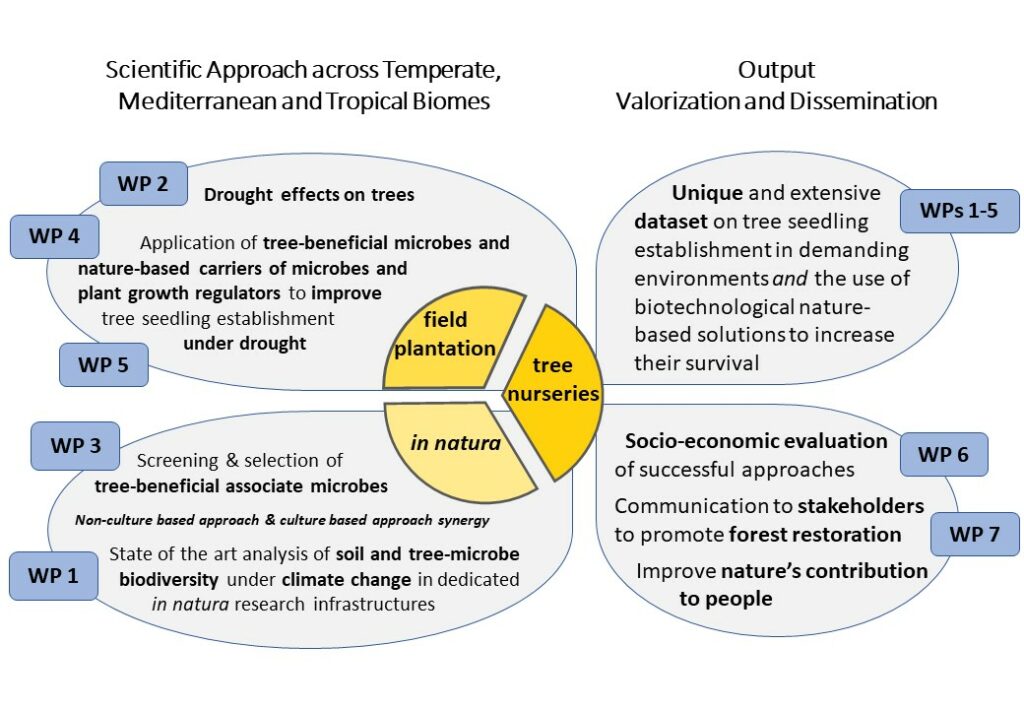WP 1. Drought effects on soil microbiota (Leader: BIAM; Contributors: UEL, UEPG, HMGU, ECCOREV, stakeholders)
Main goal: Understand the effects of drought on the soil microbiota of three natural ecosystems in Brazil, France, and Germany and how it affects the structure and the biodiversity of soil microorganisms and those associated with tree roots. That can help improve strategies for assisting trees with microbial biotechnologies
WP 2. Drought effects on trees (Leader: ECCOREV; Contributors: UEL, HMGU, BIAM)
Main goal: Elucidate the effects of drought on the physiology of native tree species and establish the protocols to perform experiments with these species using the biotechnologies proposed by the project.
WP 3. Isolation and characterization of plant associative microorganisms (PAMs) (Leader: HMGU; Contributors: UEL, UEPG, ECCOREV, BIAM, stakeholders)
Main goal: Isolate, identify, and functionally characterize strains with the potential to help plant species to cope better with stresses such as drought. These strains will be selected from samples collected on sites of Atlantic Forest in Brazil, Mediterranean Oak Forest in France, and Mesic Temperate Forest in Germany.
WP 4. Case study: Application of PAMs to induce drought tolerance in tree seedlings (Leaders: HMGU, ECCOREV; Contributors: UEL, BIAM, stakeholders)
Main goal: Improve the drought tolerance of native tree seedlings inoculated with newly isolated strains and with well-known PAMs. That will help to screen better tools to increase the success of forest restoration
WP 5. Case study: Nature-based materials as carrier systems for PAMs and plant growth regulators (PGRs) (Leaders: UEL, BIAM; Contributors: UEM, UENP, HMGU, ECCOREV, UNESP, UNISO, UFABC, stakeholders)
Main goal: Synthesize and apply eco-friendly carrier systems of PAMs and PGRs to better their positive effect on native trees under drought. The initial phase will be performed with Atlantic Forest seedlings in greenhouse experiments, and after that, nursery and field experiments will be carried out. Private and public nurseries will be engaged to test these technologies.
WP 6. Economic and social cost-effectiveness of elaborated solutions (Leaders: IDR-Paraná/UEL; Contributors: HMGU, ECCOREV, BIAM, UNESP, UNISO, UFABC, stakeholders)
Main goal: Determine the social acceptance of the proposed nature-based solutions to promote reforestation and their economic feasibility. To do that, we will engage stakeholders (mainly native tree nurseries) and analyze the cost-effectiveness and cost-benefit of the biotechnological tools developed in the previous work packages. These activities will be led by Dr. Tiago Telles (IDR-Paraná) and will also involve the teams of the three countries.
WP 7. Communication and outreach plan (Leaders: UEL, BIAM; Contributors: HMGU, ECCOREV, UNESP, UNISO, UFABC, stakeholders)
Main goal: Divulge to different members of society the results and possibilities offered by the nature-based solutions developed in the project and increase academia’s social impact. We will do it in agronomic fairs, educational activities for school children and teenagers, and posts on different web platforms.

